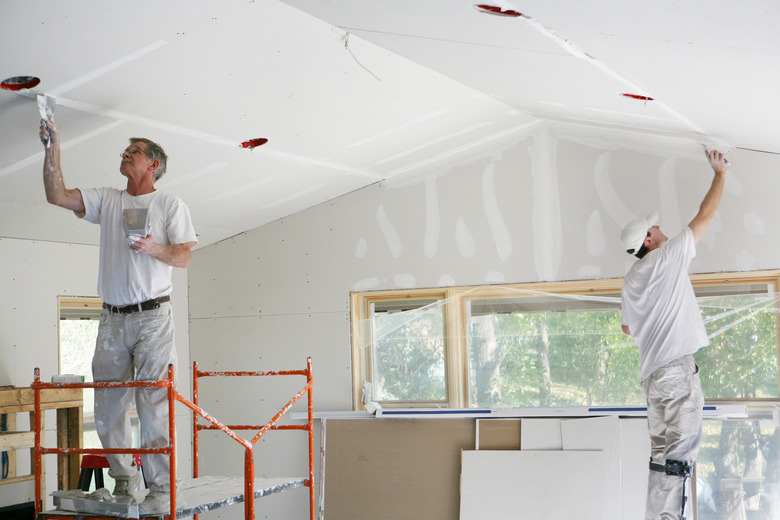What Goes On Top Of Drywall?
Drywall installation is an excellent skill to add to your DIY skill set. As a homeowner, you'll likely face opportunities to develop your drywall repair or installation skills. Knowing what products to use on top of the drywall in your home is essential to performing those tasks.
Drywall comes in several types for use in various rooms and situations around the home. Standard drywall is the most common type. Damp locations, such as bathrooms and kitchen areas, require types of water- and mold-resistant drywall, while garages often use fire-rated drywall. Regardless of the gypsum-based drywall variation you're working with, the products you use to finish it are identical: tape, corner protection, compound, and a sealer.
Using Joint Compounds
Using Joint Compounds
The first task after hanging the drywall is to fill the joints between the drywall sheets and cover the screw heads with joint compound.
Joint compound is available in premixed versions and dry powders that require mixing with water. The most common premixed compound variations are all-purpose, used for first and second coats; lightweight, which is easier to sand but may be less durable; and topping mix for use as a final coat before applying a sealer.
Dry joint compounds are for use anywhere you can use premixed versions. However, it's a little harder to sand. The differences are that powdered variations have a long shelf life, making them excellent to keep around the house for repair work; they don't need protection from freezing; and they dry more rapidly than mixed compounds. Dry joint compounds have a number designation on the product that denotes a drying time that ranges from 20 to 90 minutes.
Joint Tape and Corner Bead
Joint Tape and Corner Bead
Called taping and mudding, the next step of the finishing process uses joint compound, paper or fiberglass mesh drywall tape, and corner bead.
There are two main types of joint tape. Paper joint tape is the most common. Paper tape comes in rolls and isn't self-adhesive. The benefits of paper tape include its durability and crack resistance. Paper tape bonds drywall edges together to form a smooth surface once finishing is complete. Installing paper tape requires putting down a layer of compound over a seam, embedding the tape into the compound, and finishing by adding compound coats over the seam.
Fiberglass mesh tape also comes in rolls but is self-adhesive, eliminating the need to embed it into a layer of joint compound. Mesh tape is mold-resistant and excellent for use in damp locations. It works in any application where paper tape is appropriate as a time-saver. However, mesh tape merely bridges the gap between drywall sheets, and cracks can form if the drywall shifts.
Use corner bead to protect and fill the gap between drywall sheets at the inside and outside corners. The products come in metal, vinyl, paper, or a combination of these materials. Corner bead installation requires screws, nails, staples, adhesive, or joint compound to adhere to the corner. The corner and bead are then finished with layers of joint compound.
Apply Sealer or Primer
Apply Sealer or Primer
The final step before applying paint or another finish over your drywall is to seal its porous surface with a sealer, primer, or both. The application of a sealer is necessary to resist paint or wallpaper adhesive from soaking into the wall. Primer provides a matte surface for paint to stick to and is key to ensuring an even finish. Primer-sealers are available and perform both functions if you wish to speed up the finishing process.
